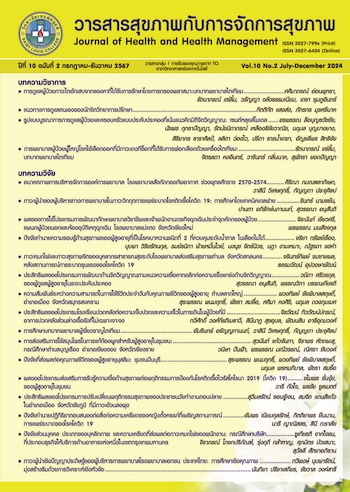Effect of the Perceived Health Belief Promoting Program on Preventive Behaviors Coronavirus Disease 2019 (Covid-19) in Community-Dwelling Older Adults
Keywords:
Health Belief Promoting Program, Preventive Behaviors, Coronavirus Disease 2019, Elderly, Health Belief ModelAbstract
Coronavirus disease is an important public health problem that affects older adults physical, mental, social, and economic Therefore, it is necessary to encourage older adults to have preventive behaviors. Coronavirus disease 2019 is appropriate and continuous. This quasi-experimental study aimed to evaluate the effectiveness of a health belief promoting program on preventive behaviors coronavirus disease 2019. Fifty eligible participants were selected for both the experimental and control groups using random assignment into the experimental group (n = 25) and control groups (n = 25). The experimental group received the health belief promoting program, while the comparison group received standard care. Data collection occurred pre- and post-intervention, utilizing questionnaires on personal information, prevention behaviors coronavirus disease 2019, and the health belief promoting program. The analysis involved descriptive statistics paired t-test and independent t-test statistics. Results revealed a significant increase in prevention behavior coronavirus disease 2019 scores post-intervention compared to pre-intervention within the experimental group (t24 = 12.05, p <.01). Additionally, the experimental group exhibited significantly higher postintervention prevention behavior scores compared to the comparison group (t48 = 2.75, p < .01). In conclusion, the health belief promoting program effectively enhanced preventive behaviors against coronavirus disease 2019. Therefore, it is recommended for adoption by community caregivers to instill health beliefs and promote preventive behaviors among older persons.
References
กรมควบคุมโรค กระทรวงสาธารณสุข. (2565). สถานการณ์ covid-19 ในประเทศไทย. สืบค้นจาก https://media.thaigov.go.th/uploads/public_img/source/310865.pdf
กรมควบคุมโรค กระทรวงสาธารณสุข. (2565). โควิดป้องกันด้วย DMHT. สืบค้นจาก https://www.ddc.moph.go.th/odpc5/news.php?news=28696&deptcode=odpc5
กรมควบคุมโรค กระทรวงสาธารณสุข. (2566). กลุ่มเสี่ยง 608 เสี่ยงอาการรุนแรงจากโควิด 19. สืบค้นจาก https://ddc.moph.go.th/odpc5/news.php?news=34871&deptcode=odpc5#
กรมอนามัย กระทรวงสาธารณสุข. (2563). คำแนะนำสำหรับผู้สูงอายุในสถานการณ์การระบาดของโรคติดเชื้อไวรัสโคโรนา 2019 (COVID-19). สืบค้นจาก https://covid19.anamai.moph.go.th
กรมสุขภาพจิต การทรวงสาธารณสุข. (2564). ความเสี่ยงและผลกระทบต่อผู้สูงอายุในช่วง Covid-19. สืบค้นจาก https://dmh.go.th/news-dmh/view.asp?id=30794
ประไพวรรณ ด่านประดิษฐ์ และพูนสุข ช่วยทอง. (2566). ผลของโปรแกรมการประยุกต์ใช้แบบแผนความเชื่อด้านสุขภาพต่อการรับรู้และพฤติกรรมการป้องกันโรคโควิด-19 ผู้สูงอายุเบาหวาน. วชิรสารการพยาบาล, 25(1), 26-38.
ปาลียา ไชยะสิด, นุชรัตน์ มังคละคีรี, และเดชา ทำดี. (2566). ผลของโปรแกรมการส่งเสริมความเชื่อด้านสุขภาพต่อการรับรู้และการมารับวัคซีนป้องกันโรคติดเชื้อไวรัสโคโรนา 2019 (COVID-19) ในกลุ่มผู้สูงอายุ จังหวัดสะหวันเขต สปป.ลาว. วารสารพยาบาลทหารบก, 25(1), 248-256.
รังสรรค์ โฉมยา และกรรณิกา พันธ์ศรี. (2563). ความตระหนักเกี่ยวกับพฤติกรรมการป้องกันการติดต่อโรคไวรัสโคโรนาสายพันธุ์ใหม่ (โควิด-19) : การเปรียบเทียบระหว่างวัย. วารสารมนุษยศาสตร์และสังคมศาสตร์ มหาวิทยาลัยมหาสารคาม, 39(6), 71-82.
วิลาสินี หลิ่วน้อย, ไพบูลย์ พงษ์แสงพันธ์, กาญจนา พิบูลย์ และธรรมวัฒน์ อุปวงษาพัฒน์. (2566). ปัจจัยทำนายพฤติกรรมการป้องโรคติดเชื้อไวรัสโคโรนา 2019 ของผู้สูงอายุในภาคตะวันออก. วารสารศูนย์อนามัยที่ 9: วารสารส่งเสริมสุขภาพและอนามัยสิ่งแวดล้อม, 17(2), 307-407.
ศตวรรษ อุดรศาสตร์, พรชัย จูลเมตต์ และนัยนา พิพัฒน์ วณิชชา. (2561). ภาระของผู้ดูแลชายที่ดูแลผู้สูงอายุโรคหลอดเลือดสมองและปัจจัยที่มีความสัมพันธ์ (การประชุมสัมมนาวิชาการและนำเสนอผลงานวิจัยระดับชาติ “ราชธานี ครั้งที่ 3). อุบลราชธานี: มหาวิทยาลัยราชธานี.
ศูนย์บริหารสถานการณ์โรคติดเชื้อไวรัสโคโรนา 2019. (2565). สถานการณ์โรคติดเชื้อไวรัสโคโรนา 2019. สืบค้นจาก https://media.thaigov.go.th/uploads/public_img/source/310865.pdf
Burn, N., & Grove, S. K. (2005). The Practice of Nursing Research: Conduct, Critique, and Utilization (5th ed.). St. Louis, MO: Elsevier.
Colin, C., Wade, D. T., Davies, S., & Home, V. (1988). The Barthel ADL Index: a reliability study. International Disability Studies, 10(9), 61-63.
Jitapunkul, S., Kamolratanakul, P., Chandraprasert, S., & Bunnag, S. (1994). Disability among Thai elderly living in Klong Toey slum. Journal of the Medical Association of Thailand= Chotmaihet thangphaet, 77(5), 231-238.
Stretcher, V., & Rosenstock, I. M. (1997). The Health Belief Model. In Glanz K., Lewis F. M., & Rimer B. K., (Eds.). Health Behavior and Health Education: Theory, Research and Practice. San Francisco: Jossey-Bass.
World Health Organization. (2023). Who is most at risk of severe illness from COVID-19. Retrieved from https://www.who.int/emergencies/diseases/novelcoronavirus-2019/question-andanswers-hub/q-a-detail/coronavirusdisease-covid-19
Downloads
Published
How to Cite
Issue
Section
License
Copyright (c) 2024 Journal of health and health management

This work is licensed under a Creative Commons Attribution-NonCommercial-NoDerivatives 4.0 International License.




